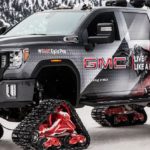It’s that time of year again—Old Man Winter is here. And he’s angry. If you live in a part of the country that sees real winter conditions (60-degree temperatures and light rain does not count, Southern California), then you’ll likely encounter snow and ice on a daily basis.
Such conditions require you to pay special attention to both your car and your driving habits. You’ll also want to make sure you’re prepared in case of an emergency.
Prepare for Harsh Conditions with these Winter Driving Safety Tips
If you get stranded during the summer, you can just hang out in shorts and a tank top until help arrives—but that’s not the case during the winter. When the snow flies, you need to be sure you’re prepared for the worst-case scenario: being stuck outside in sub-zero temperatures.
Here are a few winter driving tips that will help ensure that both you and your vehicle are ready for whatever comes your way.
1. Bring equipment to deal with the snow and ice
We’ve all been there: It’s the first snowfall of the season, and you forgot the ice scraper. Don’t be that person. Make sure you have the essentials—such as an ice scraper and shovel—onboard at all times. If you have a rear-wheel drive vehicle, you may also want to toss a bag of kitty litter in the trunk for better traction.
Also, if you plan on traveling into the mountain country, don’t forget to pack a set of snow chains. Usually, all-wheel drive and four-wheel drive vehicles can go without chains. But during extreme winter conditions, local authorities may require chains on all vehicles.
2. Pack emergency equipment for your car
Guess what? You aren’t the only one who can benefit from an emergency preparedness kit. Your car should have one, too. Consider packing the following automotive equipment:
- Compact lithium-ion jumper box
- Torque multiplier for removing stubborn lug nuts
- Basic kit of hand tools
- Tow strap
- Traction mats
- Shovel

3. Pack emergency supplies for yourself
You never know what could happen out there on the frozen tundra (or the snow-covered interstate running through the middle of suburbia). Be sure to carry emergency supplies in case you get stranded out in the cold.
You’ll want to pack the following:
- Water and food
- Blankets and warm clothing
- Medication (if you need it)
- Flashlight and batteries
- Cell phone charger
- First aid kit
- Pet food (if you’re bringing your furry friend along)
- Roadside emergency flares and hazard triangles
- Gloves
4. Take care of any needed repairs
On your way to the company Christmas party, do you want to break down and get stranded in a blizzard? We didn’t think so. Winter driving conditions can be unpredictable, and taking care of existing car problems will help you avoid such a scenario. Be sure to fix that weird noise or illuminated warning light before it’s too late.
5. Stay up-to-date on routine maintenance
If you’re one of those people who puts off essential car care—stop it. You could be jeopardizing the reliability of your vehicle and, consequently, your personal safety. Make sure you stay up-to-date on routine maintenance to avoid a potentially costly—and dangerous—break down during the winter.
6. Keep your gas tank at least half-full at all times
So, you like to live dangerously by seeing how far your car can go with the gas gauge on empty. You’re a rebel. We get it. But winter (or any other season, for that matter) isn’t the time to test your car’s limits. Be sure to keep your gas tank at least half-full at all times. That way, you’ll be prepared should you ever encounter any unforeseen road closures—a common occurrence during the winter.
7. Inspect your vehicle on a regular basis
Put on your long johns (under your regular clothes, of course) and head out into the cold to have a look at your car. Although it can be tough to make yourself check boring car stuff such as tires and fluids, doing so is essential—particularly during the winter season.
Be sure to pop the hood and check the fluids regularly. You’ll also want to check the tires for proper inflation, as well as abnormal wear and damage. The brakes should also be checked often, either by yourself (if you’re knowledgeable) or a professional.
8. Remember to practice safe driving habits
You and your 20-year old hatchback have nothing to prove. So, slow down and show Old Man Winter some respect. Practicing safe (and smart) driving during the winter will help you make it to that office Christmas party, which we mentioned earlier, in one piece.
Just in time for some eggnog and mistletoe.
Driving in Snow for the First Time? 8 Winter Driving Tips
And that leads us to our next section – winter driving tips. If you’ve lived in Minnesota your entire life, you may already know these tricks of the trade. But if you’re new to the snow and ice, keep reading for some much-needed advice.
1. Slow down
We’ve all seen that person driving way too fast in dangerous winter conditions. Hey, maybe that person was you. If so, now’s the time to change your driving habits.
The Federal Motor Carrier Safety Administration recommends reducing your speed to 1/3 of the speed limit on wet roads. Meanwhile, on snow-covered roads, you should restrict your speed to 1/2 of the speed limit or less.
2. Give yourself space
Tailgating is an unsafe habit that becomes even more dangerous when you’re traveling on the snow and ice. During the winter, as a rule-of-thumb, AAA recommends increasing your following distance to five to six seconds.
3. Avoid slamming on the brakes
Unless you want your car to turn into a bobsled (that might sound cool but, trust us, it isn’t) avoid hard braking on icy roads. Brake early and brake gradually to avoid sliding in winter driving conditions.
4. Accelerate slowly
You want to brake gradually during the winter. And you want to accelerate gradually, as well. Save peeling-out for a sunny day at the race track.
While driving on winter roads, ease into the accelerator pedal to maximize traction.
5. Get to know your car’s technology
During the winter, your car’s safety features, such as anti lock brakes (ABS) and traction control, are more vital than ever. Consult your owner’s manual to learn more about your car’s safety features and how they can benefit you during winter driving.
Oh, and one feature you’ll want to avoid using in the winter is cruise control. The technology can be dangerous when used on surfaces covered in snow and ice.

6. Leave early for your destination
During the winter, you’ll want to give yourself more time to reach your destination. If that means getting up early—and chugging even more coffee—then so be it. Winter driving can be treacherous and you want to have plenty of time for your commute.
7. Don’t rely too heavily on all-wheel drive
Some people are overly confident when driving an all-wheel or four-wheel drive vehicle during the winter. While these systems do provide extra traction, they’re no match for slick ice. Think about it: four drive wheels are going to slide over ice just as easily as two drive wheels. So, make sure to drive slowly and cautiously, even if you’ve got an all-wheel drive vehicle.
8. Invest in a set of snow tires
All vehicles—even those with all-wheel drive or four-wheel drive—can benefit from a set of snow tires (also known as winter tires). A unique tread design makes snow tires perform exceptionally well in severe winter conditions. Some examples even have built-in studs to enhance traction further.
Other things you may want to invest in for your vehicle this wintertime:
- Heated side mirrors
- Winter-ready wiper blades
- Brighter HID/LED headlights or fog lights
- Seat heating pad
Any information provided on this Website is for informational purposes only and is not intended to replace consultation with a professional mechanic. The accuracy and timeliness of the information may change from the time of publication.

















